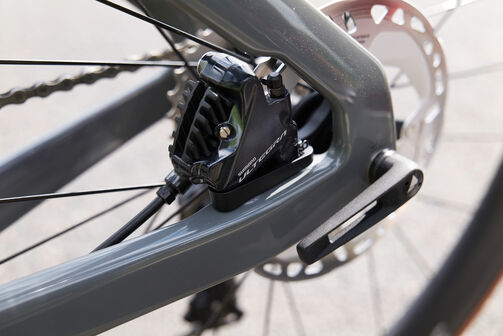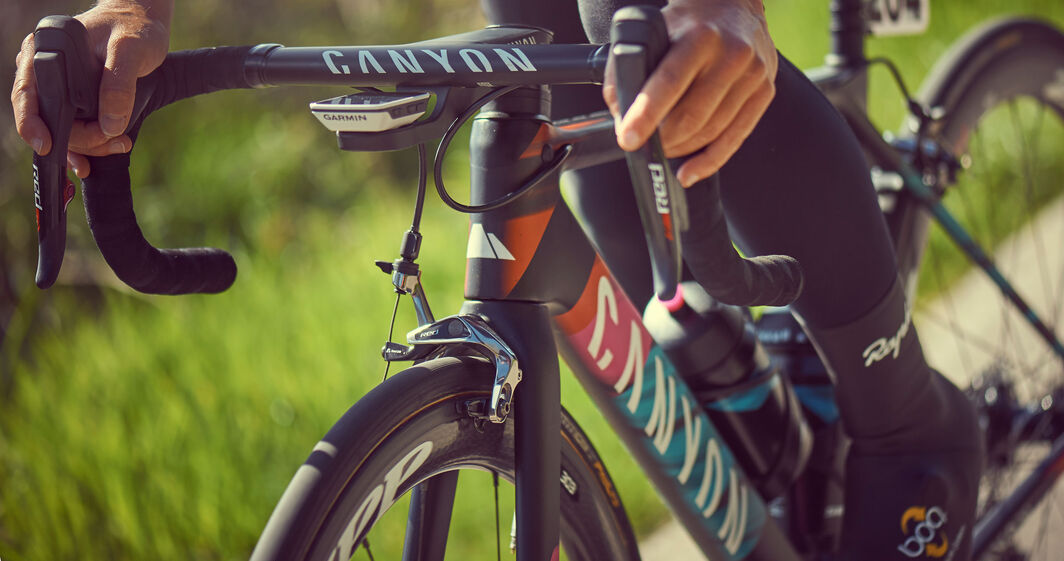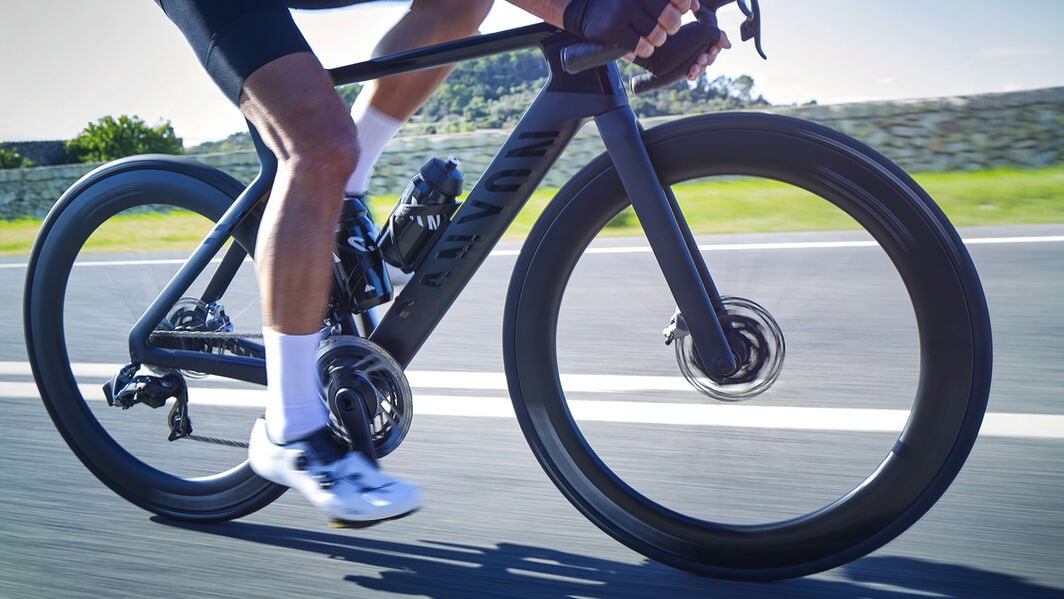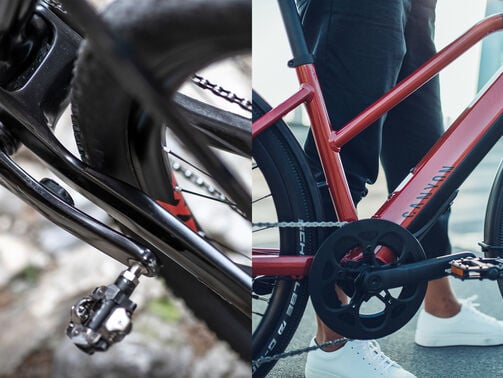Brakes for road bikes: disc brakes or rim brakes?
There once was a time when everyone agreed that disc brakes were not suitable for road bikes. However, the tides have turned, and disc brakes have become a standard feature for most road bikes.


You’re probably now wondering whether your road bike should have disc or rim brakes. Well, read on for our take on the subject. We put forward the case for each, we explain how they work, we discuss how the design affects the braking process and the advantages and disadvantages.

Rim brakes vs disc brakes
The debate about whether a road bike should have rim brakes or disc brakes is passionately contested. There are strong arguments on both sides, including considerations about weight, braking performance, and maintenance efforts. Let's start with the basics: Here, you will learn how the different brakes function.
What are rim brakes?
Rim brakes were the standard on bicycles for a long time. Their history goes back more than 100 years. A lot has happened since they were invented: innovations in materials and construction methods have opened up new possibilities for optimising rim brakes for specific types of bicycles and areas of application. At its core, however, the design has remained unchanged.
The brake system consists of two brake arms (for example; U-shape, V-shape or as cantilever arms) that the brake pads attach to. The brake arms are connected to the brake levers via a cable. When released, they are pressed against the rim of the front or rear wheel. The friction created reduces the speed.

What are disc brakes?
In disc brakes, the brake pads do not grip the rims of the wheels, but the brake rotors. The discs are located on the hubs of the front and rear wheels. The fork and frame must provide sufficient space and act as a form of attachment for the callipers. The larger the discs, the greater the power transmission. The braking effect is better with larger discs.
Disc brakes have long been standard equipment on mountain bikes. They continue to grow in popularity, particularly for those in the road cycling community. All major manufacturers have groupsets for road bikes with disc brakes, including Shimano, SRAM and Campagnolo.
Both braking systems are available in hydraulic or mechanical variations. On Canyon bikes, only hydraulic disk brakes are used. With hydraulic disc brakes, the pressure is transmitted via a line with brake fluid.
How it works:
-
You pull the brake lever, which reacts with a cylinder containing brake fluid
- The fluid is forced into the brake hose and presses the pistons of the brake calliper
- The pads press against the brake rotors on either side
Are disc brakes or rim brakes better for road bikes?
Now we come to the crunch! Should you equip your road bike with disc or rim brakes? You now know how each of them works. Allow us to give you the pros and cons of each platform.

Advantages and disadvantages of rim brakes on road bikes
Rim brakes have a lower braking force and a longer braking distance when compared to disc brakes. Nevertheless, they are usually sufficient for road bikes. After all, you're mostly riding on well surfaced roads – unlike riders of downhill mountain bikes. For example, mountain bikes rely on particularly strong braking power on steep descents in slippery conditions. If you equip your road bike with rim brakes, you should keep this in mind for a safe ride:
-
Continuous braking with rim brakes can cause the rims to heat up significantly. The high temperature can, in turn, lead to the hoses bursting. Therefore, you should brake gradually on long descents and take breaks in between.
- The braking power of rim brakes decreases when in contact with dirt, mud and moisture. Manufacturers have attempted to address this problem by improving braking performance - even under adverse weather conditions - thanks to a special surface treatment of the brake pads. However, disc brakes are still superior in this respect.
In road cycling, the weight and aerodynamics of the bike are particularly important. Here lies the rim brake’s greatest advantage: You can save up to 500 grams on the total weight of your bike just by choosing rim brakes over disc brakes. This is due to the design of the braking system itself and the use of lighter wheels and frame components. The aerodynamics do not differ significantly. Except for aero bikes, in which the braking system can be integrated into the frame and fork to create a lower aerodynamic drag.
In general, rim brakes are easy to install and worn parts are easy to replace. This is convenient for those who prefer to do their own maintenance. However, the constant grinding of the brake pads causes relatively rapid rim wear. This is especially true for wheels with carbon rims, a serious and potentially expensive problem. Here you have to weigh (no pun intended) whether the lower acquisition costs, and lighter weight of the rim brake compensate for this disadvantage.
Here you can see all the advantages and disadvantages of rim brakes at a glance:
ADVANTAGES
- Inexpensive purchase and cheaper spare parts
- Easy installation and maintenance
- Lighter (saves up to 500g in weight)
DISADVANTAGES
- Lower braking power than disc brakes
- Braking power decreases in wet and dirty conditions
- Rapid wear of the rims
Can I convert a rim brake to a disc brake on a road bike?
The answer to this question is usually a no. Bike frames and forks are typically designed specifically for one type of brake.

Advantages and disadvantages of disc brakes on road bikes
Where rim brakes lose braking power in wet and muddy conditions, disc brakes provide fast, safe, and accurate braking in all weather conditions. The larger braking surface and hydraulic pressure mean that disc brakes provide higher braking force, shorter braking distances, and require less hand pressure at the lever than their rim brake counterparts. Disc brakes also provide better modulation, allowing you to pulse the braking force, which is especially useful on long descents.
The level of braking force is mostly influenced by the diameter of the discs – the larger the disc, the higher the braking force. There is no uniform standard for the sizes. Depending on the manufacturer, different rotor sizes are installed on road bikes.
With disc brakes, you are also safer on long descents. It rarely comes to such extreme heat development that the braking performance decreases. However, if possible, you should still release the brake from time to time on long descents so that the brake discs can cool down in the airstream.
Important: New disc brake pads must first be “bedded in”. This involves performing several moderate braking operations before applying full power. Omitting this step risks causing the pads to squeal and have reduced braking power.
Now for the biggest objection of all disc brake opponents: discs are heavier compared to rim brakes. As already mentioned, you have to tackle your ride with up to 500 grams of extra weight when using disc brakes. You should consider your planned area of use: Should you sacrifice foul-weather performance for the sake of saving a few hundred grams in weight? Note that road bikes can still have a low overall weight with disc brakes. The Ultimate CFR, for example, shows what is possible here: The ultra-light mountain bike weighs only about 6 kg including disc brakes.
What about the maintenance requirements for disc brakes? It is important – just as with rim brakes – to change the brake pads before they are completely worn out. This is a little more complicated with disc brakes than with rim brakes. In addition, the brake discs must not fall below a certain thickness in material (depending on the manufacturer) to ensure they work safely. That said, the discs do not wear out nearly as quickly as the brake pads, so they rarely need replacing.
Since hydraulic disc brakes are generally used on road bikes, there are other points to consider when it comes to maintenance. Many manufacturers recommend regularly replacing the brake fluid. This is only necessary when you notice that the braking performance is decreasing. After long periods of standing, you must bleed hydraulic disc brakes.
With a little patience and skill, you can manage the maintenance of disc brakes at home. If you want to minimise the effort, rim brakes win the race. For disc brakes, you do not have to worry about the wear of the wheels.
Perfect combination: disc brakes and thru axles
In recent years, thru axles are becoming increasingly popular instead of quick releases on road bikes, cyclocross bikes, and gravel bikes. This makes the removal and installation of wheels with brake discs particularly easy. Thanks to the thru axle you can always align the wheel in the exact same position.
In addition, thru axles increase the steering precision and rigidity of the wheels. Caution: Do not operate the brake levers while the wheels are removed. Otherwise, you will press the pistons of the brake calliper together and then have to laboriously pry them apart again.
To be on the safe side, clamp a stopper or a piece of cardboard between the pistons. This way nothing can happen if you accidentally touch the levers.
Here you can see all the advantages and disadvantages of rim brakes at a glance:
ADVANTAGES
- More braking power than rim brakes
- Precise modulation of the braking power
- Shorter braking distance even in wet conditions
- No rim wear
DISADVANTAGES
- Up to 500 g more weight than rim brakes
- Higher purchase and repair costs
- Maintenance more complex than with rim brakes

Disc brakes – postmount or flatmount?
When mounting disc brakes, there are flatmount and postmount options, in addition to the (IS) international standard. With the postmount standard, the threads are located in the frame and fork. The brake calliper fits a brake disc with a 160 mm diameter (usual dimension). For larger brake discs, there are spacers available. However, these place the brake calliper further away from the fork.
For road bikes, flatmount is more interesting because of the better aerodynamics. With this standard, the threads are located directly in the brake calliper, so that the calliper and disc can be mounted much closer to the frame and fork and thus the air resistance is reduced. Currently, flatmount is only possible with 140 mm or 160 mm brake discs.
Who wins – the advocates of rim brakes or disc brakes? That's something every road cyclist must decide for themselves. After all, everyone has their own set of criteria on which to judge the merits of each system. That said, when it comes purely down to braking performance, discs clearly have the edge.
Get on your bike come rain or shine and enjoy downhill rides safe in the knowledge that your brakes will perform as expected. No matter the weather, you’ll enjoy consistent braking performance, which cannot be said for rim brakes.
The perfect modulation of braking force with minimal finger pressure provides precise, safe braking. Discs also offer you a consistently good braking performance and are unlikely to overheat on all but the longest descents. Thus, long, winding descents become a pleasure. More and more road cyclists are happy to accept the weight premium of disc brakes – especially since even road bikes with discs often have a low overall weight.
You should not be deterred by the somewhat higher maintenance effort. With a little know-how, you can maintain the hydraulic brake yourself. And if you get support from a specialist, the costs are usually reasonable. In short, if you want to be prepared for every ride and all weather conditions, it's best to opt for a road bike with disc brakes.
On fair-weather rides without long, steep descents and tight hairpin turns, a road bike with rim brakes is perfectly adequate. Many beginners in particular opt for this variant because of the lower purchase costs. There is nothing wrong with this, provided you are aware that you are making sacrifices in terms of braking performance. Also keep in mind that you will sooner or later have to deal with the wear of your rims.
With carbon rims in particular, the replacement of wheels is a cost factor that should not be ignored. You also have certain limits with rim brakes when it comes to braking at high speeds. You risk burst hoses due to overheating with continuous braking. As well as the limited function of the brakes in bad weather, you should be aware of this for a safe ride.
Tip: You’ll find a wealth of other topics that might influence your choice of road bikes in our road bike buying guide.
Discover our Road Bikes
Did this article help?
Thank you for your feedback










